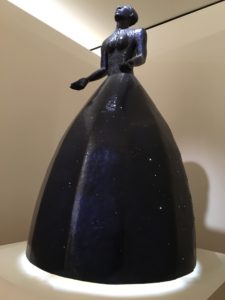
“Nocturne Navigator” Alison Saar, 1998
Collection: Columbus Gallery of Art “…commemorates those involved with the Underground Railroad…The figure’s billowing skirt, illuminated from within, shows the constellations of stars that would help guide the fugitives on their nighttime journey, while her heavenly gaze and outstretched arms suggest a mix of anguish, prayer, and gratitude.” (from museum signage)
A movie or book can be transforming. For Black History Month, I’m sharing an experience with both. In January, I attended a movie with friends: Just Mercy.
Based on the book Just Mercy: A Story of Justice and Redemption, written by Bryan Stevenson and published in 2014, the movie centers around Stevenson’s representation of death-row inmate Walter McMillian, appealing his murder conviction.
Stevenson is a Black public interest lawyer who, after graduating from Harvard Law School, went to Alabama to represent those who had been illegally convicted or poorly represented at their trials.
Just Mercy is powerful and sometimes difficult to watch. If you don’t think racism’s roots are deeply embedded in this country when you walk in, you’ll be questioning your assumption when you walk out. But the movie isn’t only about the fear, hatred, and oppression that has been visited upon Black Americans since their forced arrival as slaves. Or how fear and ignorance disfigure the oppressors. Its main message is about accepting truth, about hope and the possibility of change.
The movie includes Stevenson’s 1989 founding of the nonprofit Equal Justice Initiative (EJI), located in Montgomery, Alabama. According to its website, EJI is “… committed to ending mass incarceration and excessive punishment in the United States, to challenging racial and economic injustice, and to protecting basic human rights for the most vulnerable people in American society.”
In talks across the country, Stevenson names hope as one of the four things necessary to effect change. He calls it a “superpower” and the enemy of injustice. “It is what makes you stand up when someone tells you to sit down.”
He names another element necessary for change: proximity. In a speech at Penn State in Abington, Stevenson gave this advice: “We need to get closer to people who are suffering and disfavored so we can understand their challenges and their pain. We can’t create solutions from a distance. Decide to get closer to people who are suffering, marginalized, disadvantaged, poor. Only in proximity to those who are suffering can we change the world.”
Reading this, I thought of Pope Francis’s call, early in his pontificate, for priests to be close to the people they serve: “This is what I am asking you — be shepherds with the smell of sheep.”
Jesus lived that out. He spent time with ordinary people and those on the margins. He counted fishermen and tax collectors as his early followers and included women in his close circle of friends and disciples. He ate and drank with sinners, much to the dismay of religious leaders who kept their distance.
I’ve also been reading Howard Thurman’s book, Jesus and the Disinherited. A Black theologian, pastor, and spiritual mentor to Martin Luther King Jr., Thurman reminds us that Jesus was marginalized. He was poor, and he was a Jew in an occupied land. Jesus knew the suffering of those on the edge, or as Thurman might say “those with their backs to the wall.” He devotes a chapter to fear and its effects on people.
But Jesus’s response to marginalization was not fear. It was not violence. It was love. It wasn’t separation from those who were suffering. It was proximity. He showed us how to love and to serve our neighbor—who is everyone.
He spoke the truth. He healed on the Sabbath. He said the Kingdom of God is within us. He had hope and faith in the One who sent him and in the power of compassion. He stood up when he was told to sit down.
This month is a good time to reflect on our history, the state of our country, and the divisiveness that is increasingly expressed in violence against “the other” – not only Blacks, but also Jews, LGBTQ+ people, the poor, and immigrants.
If you’re able, see the movie (or read the book). Read Howard Thurman. They invite us to ponder how we can, as Isaiah admonishes, remove oppression, false accusations, and malicious speech from our midst; to ponder how can we share our bread with the hungry and give shelter to the homeless.
They challenge us to follow Jesus’s example of walking with the marginalized and of love, to believe that love will cast out fear and bring hope instead.
© 2020 Mary van Balen

Well done, Mary.
Thanks, Nancy.
Most of us don’t realize that millions have a fear that we will never experience: fear of the system, set up to protect the whites and the rich and those in power
Most of us don’t realize that millions have a fear that we will never experience: fear of the system, set up to protect the whites and the rich and those in power Another fine essay.
Thank you for your comment, Wilfred. What you say is so true. Those of us with privilege can’t imagine the suffering of those on the margins.
Powerful. I’ve read this several tiems. Also I am reading some of your other essays. Thanks. I’m so glad I’m on your reading list.
Ann, thank you again for letting me know that my writing speaks to you. I’m glad you’re on my list, too!